|
|
|
Sort Order |
|
|
|
Items / Page
|
|
|
|
|
|
|
| Srl | Item |
| 1 |
ID:
161887


|
|
|
|
|
| Summary/Abstract |
Anemia in children impairs physical growth and cognitive development, reducing their overall human capital accumulation. While much research has been conducted on anemia prevalence in the primarily poor and rural western provinces in China, little is known about anemia in the more developed provinces of central China. The overall goal of this study is to assess the extent of anemia in central China and determine the effect of anemia on the academic performance of students. Using data collected from fourth grade students in 25 primary schools, we find that 16–27% of sample children are anemic. Female students and students with mothers who have not migrated for work are more likely to be anemic. Importantly, using both regression analysis and matching methods, we find that students with anemia (and those with low hemoglobin levels) are more likely to perform poorly on standardized mathematics exams. These findings suggest that, over the long term, untreated anemia will perpetuate poverty by restricting the human capital development of affected children.
|
|
|
|
|
|
|
|
|
|
|
|
|
|
|
|
| 2 |
ID:
161878
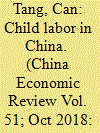

|
|
|
|
|
| Summary/Abstract |
We present the first systematic study on child labor in China. Child labor is not a negligible social phenomenon in China; about 7.74% of children aged from 10 to 15 were working in 2010, and they worked for 6.75 h per day on average, and spent 6.42 h less per day on study than other children. About 90% of child laborers were still in school and combined economic activity with schooling. Our results show that child labor participation is positively associated with school dropout rate. A child living in a rural area is more likely to work. Compared with place of residence, the gender of a child are less important. The educational level of the household head and its interaction with the gender of the household head seem to be unimportant. However, household assets per capita and household involvement in non-agricultural activities are negatively related to the incidence of child labor. A child from a household with more adults is less likely to work. The prevalence of child labor in China exhibits significant regional variations. The child labor incidence is correlated with the development level of each region: the Western region has the highest percentage of child labor, followed by the Eastern and Central regions.
|
|
|
|
|
|
|
|
|
|
|
|
|
|
|
|
| 3 |
ID:
161874
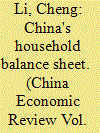

|
|
|
|
|
| Summary/Abstract |
In this paper, we compile China's household balance sheet and apply this perspective to the analysis of household financial conditions. Specifically, we first address some technical issues on the balance sheet accounts, and detail the estimations of two important asset items, “dwellings” and “automobiles.” Next, through reading the sheets, we provide an international comparative analysis, and show: (1) China's households are still on their early stage of wealth accumulation, and this trend is associated with a changing structure in favour of financial assets. (2) Although being subject to relatively low insolvency and liquidity risks, the sector has experienced, generally contrary to major developed or emerging countries, a climbing leverage cycle since the global financial crisis. These findings imply that China's policymakers should, on the one hand, make further efforts to help households accumulate wealth with an improved structure in terms of liquidity and risk diversification, and on the other hand, need to pay high attention to the increasing household financial stress and the potential risk contagion.
|
|
|
|
|
|
|
|
|
|
|
|
|
|
|
|
| 4 |
ID:
161868
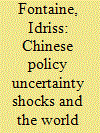

|
|
|
|
|
| Summary/Abstract |
How far could a rise in uncertainty affecting China be transmitted to other economies? This paper investigates the possible spillovers from a shock to Chinese Economic Policy Uncertainty (EPU) to developed (the United States, the Euro Area, Japan and South Korea) and emerging economies (Brazil and Russia). To take into account the non-linear nature of uncertainty shocks, we estimate a Smooth-Transition Vector Auto-Regressive (STVAR) model differentiating phases of expansion and phases of recession. We find important asymmetries in the responses to Chinese uncertainty shocks of macro-variables especially for the United States (US), the Euro Area (EA) and South Korea. Indeed, these countries display almost no response to the identified shock during booms. However, when hit in downturns, they suffer from a fall in industrial production, inflation and exports together with an increase in unemployment (except for Korea). Emerging countries (Brazil and Russia) stand out in the extent to which they significantly respond to the Chinese shock in both identified regimes. Lastly, the Japanese economy seems to be less sensitive to the Chinese shock.
|
|
|
|
|
|
|
|
|
|
|
|
|
|
|
|
| 5 |
ID:
161870
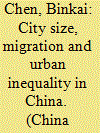

|
|
|
|
|
| Summary/Abstract |
This paper examines the relationship between city size, migration, and urban income inequality using a subsample of the 1% population census of China in 2005. We calculate various measures of within-city income inequality for 252 Chinese cities. It is found that overall city income inequality is significantly and positively correlated with population size. As migration is crucial in determining city size distribution in China, we focus on exploring the role of massive migration into big cities in shaping this size-inequality relationship. We find that the share of migrants alone accounts for more than 40% of the city size inequality premium. This is primarily because migration leads to higher skill premiums in larger cities by changing the skill composition of workers in those places.
|
|
|
|
|
|
|
|
|
|
|
|
|
|
|
|
| 6 |
ID:
161881


|
|
|
|
|
| Summary/Abstract |
We evaluate factors affecting the demand for MOOC by estimating its demand function in OECD countries and in China. We apply a Big Data approach to construct a proxy for MOOC demand using Google Trends for OECD and Baidu Index for China. Based on estimation results of various panel data models, we find that in both cases, higher unemployment promotes MOOC demand. However, in OECD countries, the proportion of individuals with high school level or higher education have positive and significant effects on MOOC demand, while in China, we observe positive and significant effects from internet speed and average income.
|
|
|
|
|
|
|
|
|
|
|
|
|
|
|
|
| 7 |
ID:
161871


|
|
|
|
|
| Summary/Abstract |
This paper estimates urban and rural poverty rates across five Chinese province-level administrative regions (Shanghai, Liaoning, Guangdong, Henan and Gansu) using representative household survey data from the China Family Panel Studies survey. The types of government transfer payments that households in poverty received and the ability for such payments to lift them from poverty are also assessed. Consistent with published estimates from China's National Bureau of Statistics, the results highlight substantial disparities in poverty rates between provinces in 2014. Nevertheless, for each province, the poverty rates estimated from the survey data were notably higher than the official figures. Although the problem of rural poverty continues to be a significant focus of Chinese policymakers, the results suggest that the poverty rate was higher in urban than in rural areas in most provinces. This partly owed to the higher cost of living in urban China, which is captured in the poverty lines defined for this analysis. In 2014, the most common types of government transfer received by households in poverty were agricultural subsidies or social assistance - principally the dibao. Regarding the latter, the results suggest some improvement in payment targeting in rural areas between 2012 and 2014, but the majority of dibao recipients in most provinces still had income above the defined poverty line in 2014. Furthermore, across all provinces, the vast majority of households living below the defined poverty line did not receive social assistance at that time.
|
|
|
|
|
|
|
|
|
|
|
|
|
|
|
|
| 8 |
ID:
161879


|
|
|
|
|
| Summary/Abstract |
This paper investigates the effects of the most widespread education subsidy—the “two waivers, one subsidy” policy—on school enrollment and nutrition intake among rural children from needy families in China. Using the difference-in-difference identification strategy and data from the China Health and Nutrition Survey, we find this policy was quite influential for poor children of junior high school age, increasing their school enrollment by 11 percentage points. When stratified by gender, the influence was found limited to male students. Besides, the subsidy increased the calorie and fat intake among junior high school-aged children, suggesting that part of the savings from the education expenses was transferred to food expenses.
|
|
|
|
|
|
|
|
|
|
|
|
|
|
|
|
| 9 |
ID:
161888


|
|
|
|
|
| Summary/Abstract |
The incompatibility of female time allocation between labor supply and child care has been one of the explanations of low fertility rate experienced by many countries. Non-parental care, especially that from grandparents or formal care, helps alleviate the constraint females facing and thus permits the families to have more children. Extending from the theoretical framework in Ermisch (1989), this study incorporates grandparents' health status to provide a theoretical justification for its effect on family size. Based on the data taken from the Panel Study of Chinese Family Dynamics (PSFD) from 2006 to 2011, it is found that grandparents in different age groups exhibit differential influence on family fertility decisions. Specifically, healthy grandparents in the 55–64 age group are found to have a persistent and positive impact on the family's probability of having more children as predicted by the theoretical model. Nonetheless, when grandparents' health effect is compounded by the age effect, more elderly healthy grandparents in the 75-and-up group will reduce the couple's desire for more children. This negative effect can be explained by the couple's consideration of lower childcare quality and larger age gaps leading to great differences in the childcare ideas. The number of healthy grandmothers are found to have an even greater influence on family fertility decisions, suggesting grandmothers still take the major responsibility of childcare in the family and thus constitute an absolutely crucial resource in the Chinese society.
|
|
|
|
|
|
|
|
|
|
|
|
|
|
|
|
| 10 |
ID:
161873


|
|
|
|
|
| Summary/Abstract |
Green growth has become a new direction for Chinese economic development in the 21st century. Indeed, sustainable agricultural development is particularly important in China due to limits on resources and the presence of the largest population in the world. In this paper, we propose a novel decomposition of the overall inefficiency into three components of technical, mix, and scale effects at aggregate level by allowing for desirable and undesirable outputs in a non-parametric framework. We empirically investigate economic and environmental performance associated with resource misallocation (represented by input/output mix) in Chinese agricultural sector across the 31 provinces over the period 1997–2014. Our results show that average overall inefficiency in Chinese agricultural sector is 9.13% during the sample period, which suggests there exists a 7.94% possible improvement for gross output value and 1.19% potential reduction for carbon emission. Moreover, we find inefficiency is mainly due to the mix effect that requires an improvement in reallocation of inputs and this may be related to the ongoing supply side structural reforms in China. We also present a dual model of by-production technology for shadow price analysis and report upward trended carbon abatement costs in Chinese agriculture.
|
|
|
|
|
|
|
|
|
|
|
|
|
|
|
|
| 11 |
ID:
161889


|
|
|
|
|
| Summary/Abstract |
This paper studies the growth channels of human capital using the provincial level panel data in post-reform China. Specifically, it aims at distinguishing between the “factor-accumulation channel,” whereby human capital augments production as an input factor, and the “productivity channel,” whereby human capital affects output by raising total factor productivity. Our system GMM estimation results support the hypothesis that different types of human capital affect economic growth through different channels: Basic human capital contributes to growth via the “factor-accumulation channel” and advanced human capital via the “productivity channel,” both individually and simultaneously.
|
|
|
|
|
|
|
|
|
|
|
|
|
|
|
|
| 12 |
ID:
161877


|
|
|
|
|
| Summary/Abstract |
The People's Republic of China (PRC) has achieved significant improvements in educational attainment levels since the market-oriented reforms began almost four decades ago. However, there are still educational gaps among different groups and education inequality remains an issue. Addressing urban disparities remains a pertinent matter in optimizing China's transition towards a knowledge-driven economy. This paper investigates education inequality in urban China, using subgroup and regression-based decompositions of inequality of educational attainment, to evaluate whether the determinants to urban education inequality are similar within and across regions. Using the urban datasets from the China Household Income Project surveys for 2013, education inequality was measured for up to 100 cities from 14 provinces. The results reveal heterogeneity in educational attainment, education inequality, and the determinants of education inequality in urban China. Regression-based decompositions of education inequality revealed that the determinants of education inequality are not homogeneous between and within regions and provinces. While the type of middle school and National Higher Education Entrance Examination scores are predominantly among the largest contributors, the size and order of their contributions vary among different regions, provinces and age cohorts. Other major contributing factors varied from parents' occupation to parent's education and parental employment type. The results imply that since cities aren't homogeneous, therefore, they have different contributing factors towards education inequality. The results suggest that location-specific policy targets and priorities may produce more favorable outcomes in reducing education inequality.
|
|
|
|
|
|
|
|
|
|
|
|
|
|
|
|
| 13 |
ID:
161869
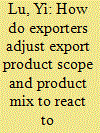

|
|
|
|
|
| Summary/Abstract |
Using Chinese customs data covering all exporters over 2000–06, this paper empirically investigates how Chinese multi-product exporters adjust their product scope and product mix to react to U.S. antidumping. The estimation results indicate that surviving exporters experiencing antidumping would reduce their overall export product scope and concentrate on fewer more successful products, although the overall export value does not change. Specifically, they drop many pre-existing peripheral export products and simultaneously introduce new products that are closer to their main industry into the U.S. market. The analysis also finds that the sophistication of surviving exporters' export product mix increases in response to antidumping, and they export more products that have higher upstreamness.
|
|
|
|
|
|
|
|
|
|
|
|
|
|
|
|
| 14 |
ID:
161872


|
|
|
|
|
| Summary/Abstract |
Using a social network is an effective way to carry out a job search. This study examines whether Chinese social network, guanxi, leads to better job-worker match and less job turnover. Using a two-dimensional measurement of guanxi, the results of logistic regressions indicate that guanxi is actively used by job seekers who do not match to the employers’ requirements. This finding implies that guanxi may be unfairly used during job searches. Meanwhile, survival analysis shows that guanxi does not lead to less job turnover. The implication of this study is that guanxi should be used for informational purposes, which would enable job seekers and potential employers to avoid information asymmetry in the job search process.
|
|
|
|
|
|
|
|
|
|
|
|
|
|
|
|
| 15 |
ID:
161876


|
|
|
|
|
| Summary/Abstract |
This paper investigates trends in educational inequality in China, focusing on the contribution of ‘inequality of opportunity’ to these trends. Utilising the China Family Panel Studies survey for 2010 and 2012, we measure the inequality in individual educational outcomes (measured in years of schooling) in aggregate and for each of ten birth cohorts. We run regressions to identify the key determinants of these outcomes, all of which can be classified as ‘circumstances’ that lie beyond the control of each individual, and which reveal important variations in the magnitude and significance of key determinants across birth cohorts. The results are then used to calculate the share of ‘inequality of opportunity’ in overall educational inequality. The lack of equal opportunity for Chinese people with regard to their educational outcomes is shown to stem primarily from the divisive hukou system, with further significant contributions from father's education, birth cohort, province, parents' Communist Party membership, gender, family size and ethnicity, in that order.
|
|
|
|
|
|
|
|
|
|
|
|
|
|
|
|
| 16 |
ID:
161890


|
|
|
|
|
| Summary/Abstract |
Intangible capital is treated as an important determinant of economic growth in the age of knowledge economy. It has however attracted less attention in China largely due to measurement impediment. This study aims to measure intangible investment and examine its contribution to regional economic growth in China. The results show that both the coastal and interior regions in China enjoyed high growth in intangible investment during 2003–2014, especially after the year 2008. Moreover, it is found that regional disparity in intangible capital is widening and that this trend is mainly driven by the enlarging gap in investment in computer software and architecture designs. In addition, it is observed that economic competency capital is neglected in both regions, implying generally poor enterprise management in China. When intangible capital is considered, growth accounting exercises show higher labor productivity growth together with a larger effect of capital deepening in both regions. Coastal regions tend to benefit more from intangible capital due to the advancement of computerization. If the contribution of computer software in the interior region was as large as that in the coast region, labor productivity growth of the interior would be 0.5 percentage points higher than its current level. Finally, the estimates of the contribution of total factor productivity to economic growth would be biased if intangible capital is not considered.
|
|
|
|
|
|
|
|
|
|
|
|
|
|
|
|
| 17 |
ID:
161875


|
|
|
| 18 |
ID:
161885
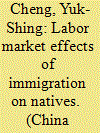

|
|
|
|
|
| Summary/Abstract |
The local labor market in Hong Kong is characterized with two distinct features: the limited geographical mobility of native workers and their ethnic homogeneity to immigrants. Both of these features may exert a greater labor market pressure on native workers to immigrant inflows in Hong Kong compared to other local markets. Moreover, over the past three decades, new immigrants in Hong Kong are disproportionately less educated youths from Mainland China who are admitted through the one-way permit scheme for family reunion. In this paper, we introduce an immigrant exposure measure capturing the extent of exposure of natives in a given skill group to immigrants in terms of occupational competition, and identify the effects of immigration on natives' employment and earnings by relating the changes in natives' employment and earnings across skill groups to their changes in the immigrant exposure measure. To address the potentially endogenous responses of workers to occupational demand shocks, we further construct the projected immigrant exposure measure applying the lagged skill-group specific occupational employment structure to the contemporary skill distribution and employ it as a Bartik-style instrument. We find that competition from immigrants reduces the employment prospect of native females but not that of native males. However, for native males competition from immigrants yields significant adverse earnings effects, whereas for native females such earnings effects – though still negative – are smaller in magnitude and less often statistically significant.
|
|
|
|
|
|
|
|
|
|
|
|
|
|
|
|
| 19 |
ID:
161880


|
|
|
|
|
| Summary/Abstract |
China's unemployment rate for new college graduates has increased significantly in recent years, and many people attribute this increase to the higher education expansion policy. In this paper, we use three nationally representative data sets for 2000, 2005, and 2010 to investigate the short and medium term effects of the expansion policy on the unemployment of college graduates. Treating higher education expansion as an exogenous shock and using a difference-in-difference (DID) strategy, we find that this policy increased the unemployment rate of new college graduates in the short run, but the unemployment rate kept declining and the dis-employment effect mostly disappeared after five years. We also find some heterogeneous effects by gender, region, and city.
|
|
|
|
|
|
|
|
|
|
|
|
|
|
|
|
| 20 |
ID:
161882
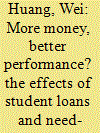

|
|
|
|
|
| Summary/Abstract |
The goal of this study is to examine the effect of student loans and need-based grants on financially disadvantaged student academic performance in China's higher education. We used a large sampled data from 101 universities to conduct our study. By employing different matching methods, we found that receiving a student loan did not improve student academic performance, but slightly increased students' likelihood of doing a part-time job. Likewise, receiving a need-based grant had no significant effect on student academic performance. We argue that current financial aid programs do not yield any measurable improvement on student performance. Reform and more rigorous evaluations are needed to design an effective financial aid program to promote the development of higher education in China.
|
|
|
|
|
|
|
|
|
|
|
|
|
|
|
|
|
|
|
|
|